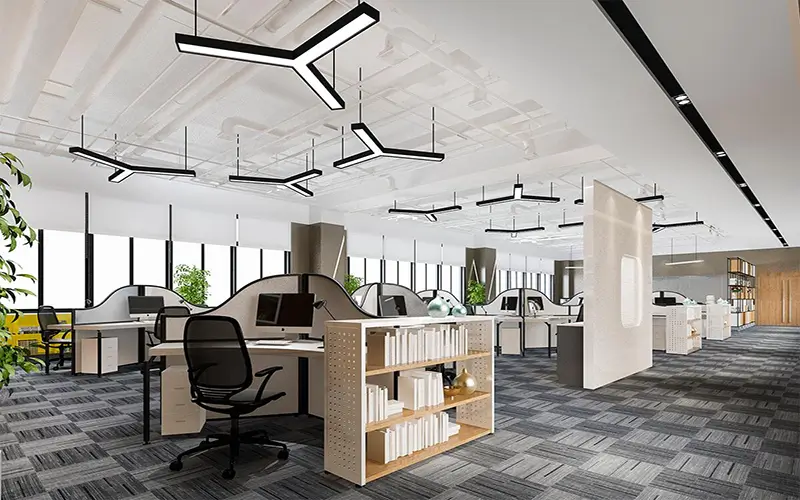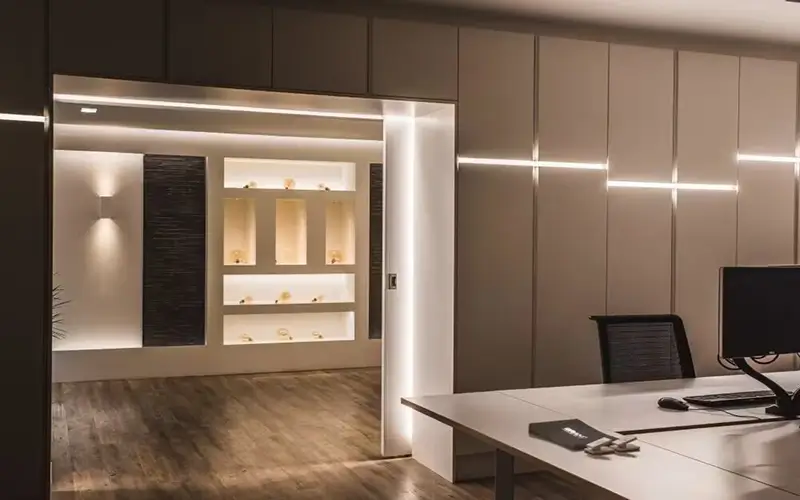
Everyone knows that office lighting in the work area can directly affect the team’s mood, work efficiency, and productivity. So, it is important to choose the right lights for the offices. In this article, we discuss the best lighting practices to improve your work environment. We’ll cover types of lighting equipment, brightness, color temperature, and more. And help you choose the right type of lighting for your unique office.
What is Office Lighting?
Office lighting refers to lighting systems used in indoor work spaces such as offices. The main thing is to provide sufficient and appropriate lighting for the task, productivity, and comfort. It plays a vital role in creating a favorable task-lighting environment, reducing eye strain, and boosting employee productivity.
The Importance of Office Lighting
Office lighting is very important to every aspect of the work environment and the work of employees. Office lighting can provide the following benefits:
Increased Productivity: Adequate lighting ensures employees can see their tasks clearly. Thereby reducing your own mistakes and keeping a clear head at work at any time. Plus, proper lighting levels can prevent eye strain and make it easier for employees to read documents, work on computers, and perform other tasks efficiently.

Comfort: Studies show that poor lighting can lead to eye strain, headaches, and even long-term vision problems. Good office lighting minimizes glare, shadows, and flicker, creating a visually comfortable environment.
Mood and Well-being: Lighting at different temperatures has different effects on mood. Good office lighting helps to enhance the beauty of the office space, so as to feel a sense of warmth and well-being. It can also enhance the overall ambiance, creating a more welcoming and inviting environment for staff and visitors.
Things to Consider When You Choose Office Lighting
When purchasing office lights, you need to consider the following important factors:

Office Lighting Brightness
The brightness of a lamp is measured in lumens, and the light output per unit area is measured in lux (lx). First, make sure that different areas use different brightness levels.
For example, general lighting areas should use higher brightness, while recreational areas can use soft lighting. A brightness level of 500–1000 lx is considered optimal for an office environment. Of course, you need to choose a combination of different brightness levels depending on the nature of the functions performed in the room.
Color Temperature
The color temperature of office lighting also plays a decisive role in the well-being and productivity of employees. The color temperature of the light can affect the ambiance. A warmer light will be more suitable for a relaxing area. Cooler lights are better for work areas and focus. So, how to choose the ideal color temperature for office lighting?
Light Intensity
The desk is one of the most important parts of the office. Because this is where employees do their work and discuss ideas.
If the light intensity is not enough, this may cause eyestrain, which can lead to loss of concentration and affect work efficiency. If the light is too bright, it has the potential to cause visual discomfort and glare, and it can also reduce work efficiency and employee health.
Lighting Purpose
Different work areas require different levels and types of lighting. We need to know the specific tasks that each area of the office performs and choose the appropriate lighting. For example, brighter lighting is required in the work area. And in the resting place in the pantry, milder lighting is needed.
Color Rendering
For office lighting, it is also necessary to choose lighting with a high color rendering index (CRI) for accurate color rendering. Of course, the higher, the better (CRI > 90 or more). So that employees can quickly see their tasks and products. This is especially important in environments where color differentiation is critical, such as design studios or production product areas.
Cost
When considering office lighting design, it is also important to consider the cost. Because the lighting time will be slightly longer, about 12-14 hours, or even more. Therefore, there is a need for LED lights that are energy-efficient and power-saving, so as to better control the power used.
What kinds of Lights Are Suitable for Office Lighting?
Now, we know a little bit about office lighting. Next, let’s discuss what types of luminaires can be used to illuminate office areas.

- LED Spotlights, Track lights, and Linear Lights
These lights are the best choice for efficient task lighting, and they serve a specific purpose. You can choose from these lamp designs, colors, and types of modern task lights mainly to enliven the atmosphere of the workplace. - Panel Light
Panel lights are rectangular luminaires, most of which are installed on office ceilings. Primarily in large work areas or with a large number of employee cubicles. Therefore, panel lights are task lighting rather than providing light for a specific location. In addition, the design of the panel light is simpler and more elegant. It also increases productivity and visibility in the office. - Ceiling Light
Suspended lights are best for taller office ceilings. The higher the ceiling, the greater the power of the lamp to get better lighting. While these lights provide general illumination and are highly ornamental, you’ll also be adding to your electricity and maintenance costs. - LED Strip Lights
LED strip lights are also installed in office lighting, and are usually installed on the wall to create a wall-washing effect. There are also LED strip lights used in the pendant lights, forming a minimalist style of linear lights. Create a minimalist atmosphere. We are a factory producing LED strip lights and LED neon flex, any interest tells us.
What Should be Avoided in Office Lighting?
Office lighting plays a vital role in creating a productive and comfortable work environment. To ensure optimal lighting, some of the following should be avoided:
Direct Overhead Lighting
Eyestrain and reduced visibility if lights are placed directly over workers’ heads. So placing the lights at an angle can prevent glare on the screen and cause eye strain for workers. If the lights are fixed, you can change the setup and layout of your office so that the lights don’t cause glare.
Flickering Lights
Flickering lights can cause discomfort and eye strain. So choose high-quality lamps and bulbs, so that there will be no obvious flicker.
Insufficient Lighting
Insufficient lighting can lead to eye strain and reduced productivity. It is therefore imperative to ensure that the work area is evenly illuminated and that employees can perform tasks comfortably.
Unsuitable Color Temperature
Different work areas require different color temperatures. Do not use lighting that is inappropriate for the current lighting task. So, cool white light might be better for areas where you need to maintain your focus, while warm white light might be better for areas where you need to relax.
Poor Color Rendering
The color rendering index (CRI) measures how accurately a light source depicts colors. High CRI lighting can see colors and affect visual clarity. Choose lighting with a high CRI above 90 to accurately represent colors in the office.
Lack of Dimming Control
Install a dimmer controller or adjustable lighting solution. Active, adjustable lighting adjusts lighting during tasks. Employees can therefore customize the lighting to their liking.
Ignore Natural Light
Natural light has many benefits, including improving mood and energy levels. Avoid blocking windows with heavy curtains or barriers to keep natural light from entering the office.
Therefore, for office lighting, we must consider the preferences of employees. Simultaneously and focusing on creating a well-lit, comfortable, and visually pleasing workspace can help create an office environment where employees are more productive and motivated.
Final Thoughts
Office lighting directly affects employee productivity and mood. In some extreme cases, eye disorders, migraines, and depression may result.
So, we hope you understand the importance of office lighting design. Make sure to choose a fixture design with neutral and cool color temperatures, high CRI, and reduced glare. Give your workers the control to change lighting settings. Finally, try to use natural light as much as possible. Your employees will thank you for it.
FAQs
There are many factors to consider when it comes to office lighting. Factors such as task requirements, color temperature, CRI, energy efficiency, and glare control need to be considered.
Generally speaking, a color temperature of 3500K to 4500K (neutral to cool white) is suitable for office workspaces. And 2700K-3000K is more suitable for the leisure area of the office, drinking coffee and relaxing.
Yes, very direct impact. Proper office lights can enhance focus at work and reduce eye strain. It can also have a positive impact on employee productivity and well-being.
Yes, natural light is the best light for an office. Therefore, when installing lighting in the office, be sure to take natural light into account. When balanced with proper artificial lighting, natural light can enhance the office ambiance and reduce energy costs.
The main thing is not to install lights directly on the headlights, use as much indirect lighting, anti-glare lamps as possible, and place light sources correctly to minimize glare.
